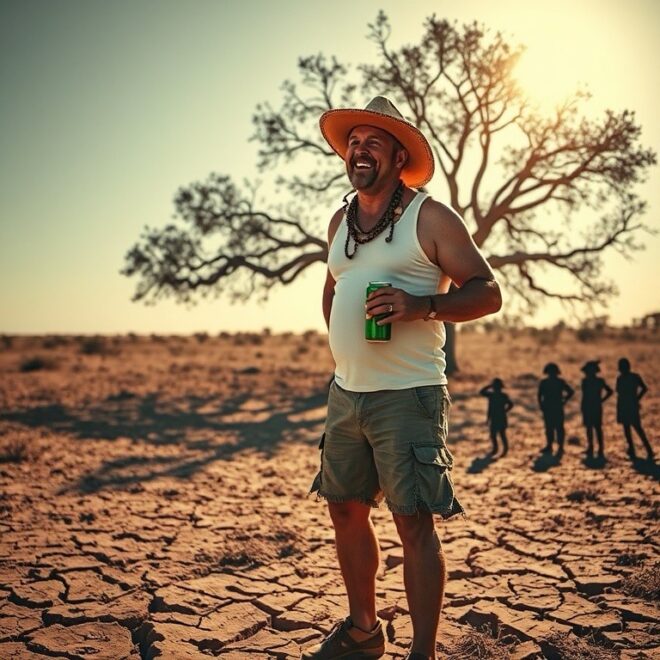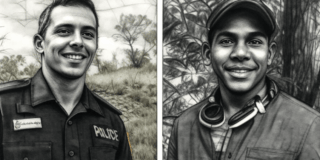
G’day, mates! Pull up a stump, grab a cold one and let’s have a proper yarn about one of the most persistent myths in Australian history – the idea that white males, decked out in their iconic Akubra hats, single-handedly built the so-called “Lucky Country.” This tale paints a picture of rugged, fair-dinkum blokes, pickaxe in one hand and a tinny of VB in the other, shaping the vast sunburnt land into a prosperous nation that attracts migrants from all corners of the globe. According to this narrative, these white fellas carved cities from red dirt, tamed the unforgiving outback, invented iconic Aussie staples like the meat pie, and forged a society so brilliant that the rest of the world looks on in envy, packing their bags to join the party.
But crikey, that story deserves a good roasting on the barbie of historical scrutiny. The myth that white males “built” Australia is not just an oversimplification – it’s a downright fairy tale as fanciful as a kangaroo in a tuxedo. It’s a selective retelling that conveniently overlooks the 60,000 years of Indigenous ingenuity, the waves of diverse migrants who did much of the heavy lifting, and the complex realities behind why people continue to migrate here. The truth is Australia’s story is one of co-creation, conflict, resilience and multiculturalism, not a one-man show starring white blokes in cork hats.
In this post, we’ll take a satirical yet serious squiz at the “white bloke builder” myth, unpacking how it’s built on stolen land, exploited labour, and a hefty dose of collective amnesia. Meanwhile, migrants keep arriving – not for some mythical white utopia – but for the vibrant, diverse mosaic they themselves help create. Strap yourselves in, folks, because this is going to be a ripper of a ride.
The Real Beginning: Indigenous Australia
Let’s start at the real beginning, long before Captain Cook “discovered” this sunburnt continent. For over 60,000 years, Aboriginal and Torres Strait Islander peoples built complex, sophisticated societies across Australia. These were not nomadic wanderers as colonial narratives often suggested, but communities with intricate social structures, laws, languages, and land management practices that would make modern sustainability efforts look like a hipster’s compost bin.
Indigenous Australians engineered aquaculture systems, constructed stone houses and villages, and practised fire-stick farming – a controlled use of fire to encourage growth and maintain healthy ecosystems. The boomerang, the didgeridoo, and the Dreamtime stories are just some of the cultural contributions that underpin Australian identity. Without the profound Indigenous knowledge of bush tucker, water sources and seasonal cycles, those first white settlers would have been lost in the scrub, starving and muttering about how convict life back home was easier.
So, if white males truly “built” Australia, they must have time-travelled back to invent these foundational elements of culture and survival. Satirically speaking, the myth quickly unravels when faced with the reality of 60 millennia of Indigenous innovation.
1788 and the Arrival of the British: Terra Nullius and Its Consequences
Fast forward to 1788, when the British arrived with their fleet of convicts, soldiers, and flags. Declaring Australia terra nullius – “nobody’s land” – they ignored the thriving Indigenous populations estimated at up to three million people. What a satirical stroke of colonial genius! White males, many of them petty criminals shipped from Britain, “built” Australia by simply nicking it from its original owners.
Governor Arthur Phillip planted the Union Jack at Sydney Cove, marking the beginning of a white man’s world. But the reality was far from the heroic pioneer narrative. These early settlers were busy battling disease, starvation and Indigenous resistance led by leaders like Pemulwuy of the Eora nation, who conducted raids that kept the colonists on edge. If white males “built” early Australia, it was with Indigenous spears prodding them along every step of the way.
Colonisation was not construction – it was destruction. Smallpox and other introduced diseases wiped out up to 90% of some Indigenous groups. Massacres and forced removals cleared the way for sheep stations and gold mines. The Frontier Wars, lasting over a century, were Indigenous resistance efforts that shaped what would become the so-called “pioneer spirit.” Imagine a white squatter boasting, “I built this homestead,” while conveniently forgetting the Wiradjuri or Yorta Yorta knowledge that taught him how to navigate rivers or manage fire to prevent bushfires.
Even Australia’s beloved Aussie Rules Football owes its origins to marn grook, an Indigenous game. Yet white males codified it, took credit, and turned it into a billion-dollar industry. The myth begins to look more like a cover story than history.
The Gold Rush and Multicultural Contributions
Jumping ahead to the 1850s gold rushes, Australia really began to attract migrants – not for white male brilliance, but for shiny nuggets buried in the earth. Tens of thousands arrived, including over 40,000 Chinese prospectors who brought expertise in mining techniques, market gardening, and even furniture making. These migrants built roads, introduced new crops like rice and vegetables, and enriched Australian cuisine with innovations like the dim sim – a bastardised version of dim sum.
But the irony was sharp. White males, fearing competition, enacted poll taxes and incited riots like the Lambing Flat massacres to keep the “yellow peril” out. If white males built the goldfields, why did they rely so heavily on Chinese labour to dig the shafts, only to claim the glory? It’s like a bloke winning the lottery with a ticket he nicked from his mate.
Federation and the White Australia Policy
By the time Australia federated in 1901, the “white bloke builder” myth was cemented through the White Australia Policy – a blatantly racist set of laws designed to preserve a “pure” society built by white hands. Prime Minister Edmund Barton proudly proclaimed the policy would keep Australia for the “white man,” ignoring that the Constitution itself drew inspiration from Indigenous governance models and consensus-based decision-making.
White males “built” a nation by excluding others, yet migrants still slipped through. Afghan cameleers opened the outback for exploration, Italians planted vineyards in the Barossa Valley, and Greeks brought souvlaki to suburban dinner tables. Without these “wogs” and “dagoes,” Australia might still be a dusty sheep paddock where white blokes survived on damper and billy tea.
Post-War Migration and the Multicultural Nation
Post-World War II, Australia’s labour shortages led to the “Populate or Perish” campaign, bringing in two million immigrants by 1965. These included British “Ten Pound Poms,” displaced Europeans, Italians, Greeks, and Yugoslavs – many of whom literally built modern Australia. The Snowy Mountains Hydro-Electric Scheme, an engineering marvel powering the east coast, was constructed by over 100,000 workers from 30 countries, many non-white and non-male. Italian tunnellers, Polish engineers, and women in support roles turned rivers backwards.
If white males alone had built it, it’d be a garden hose trickling into a billabong. Migrants filled factories, farms, and mines, boosting the economy and creating the multicultural suburbs that define modern Australia.
The End of White Australia and the Rise of Asian Migration
The White Australia Policy ended in 1973 under Gough Whitlam, opening the door to waves of Asian migrants: Vietnamese boat people fleeing war, Lebanese escaping civil strife, and later skilled Indians and Chinese professionals. Multiculturalism became official policy in the 1980s, with migrants contributing across sectors from technology to cuisine.
Take wi-fi technology, for example. While John O’Sullivan, a white male scientist, was part of the CSIRO team that invented it, the broader tech sector thrives today thanks to Indian coders and Chinese entrepreneurs. Satirically, white males may claim Silicon Valley envy, but without global talent pulling all-nighters, Australian startups would still be coding on Commodore 64s.
Indigenous Contributions Amid Persistent Myths
Indigenous contributions continue to shape Australia despite persistent myths. Cathy Freeman’s lighting of the Olympic flame in 2000 symbolised reconciliation, while artists like Albert Namatjira captured the outback’s soul. Indigenous bush medicine inspired pharmaceuticals, and landmark legal cases like Mabo (1992) overturned terra nullius, forcing white Australia to confront its stolen land history.
Yet, the myth lingers. The 2023 Voice referendum failed partly due to fears of “dividing” a nation supposedly unified by white male pioneers. If white males built unity, why do Indigenous Australians still face lower life expectancies and higher incarceration rates?
Women and Migrants: The Overlooked Builders
Women’s roles in building Australia are hilariously overlooked in the “white male builder” narrative. White women like Edith Cowan, Australia’s first female MP, pushed for social reforms, while Indigenous women like Lowitja O’Donoghue led health initiatives. Migrants, too, have been essential: Filipina nurses staff hospitals, Somali entrepreneurs run cafes. If white males had built healthcare, it’d probably still be leeches and rum. Instead, diverse migrants form the backbone of Medicare.
Contemporary Migration and Australia’s Future
In 2025, migration trends debunk the myth further. Net migration hit 440,330 in the year to April – the second highest ever – driven by skilled workers, students, and refugees from India, China, the Philippines, and beyond. People don’t come to a white male utopia; they come for jobs in mining (built on Indigenous land), tech (powered by global talent), and education (funded by international fees).
Housing shortages spark debates, but experts blame poor planning by predominantly white male governments. Migrants arrive, chuckle at the myth, then open kebab shops, code apps, and win Nobel Prizes alongside their colleagues.
Culture, Economy, and Society: A Collective Creation
Cultural icons like the Sydney Opera House, designed by Dane Jørn Utzon (a white male), were built by Italian labourers and inspired by global architecture. Barbecue traditions evolved from Indigenous cooking pits. Vegemite, brewed from yeast extract, was popularised by migrants during wartime rationing.
Australia’s economy relies heavily on migrant labour. Mining giants like BHP depend on fly-in-fly-out workers from Asia and Africa. Pacific Islanders harvest crops under schemes reminiscent of indentured labour. Without these contributions, white males might be stuck eating imported spam.
Busting the Migration Myths
The “they’re taking our jobs” cry ignores that migrants create more jobs by starting businesses at twice the rate of locals. Media perpetuates the “great white male” trope from Crocodile Dundee to modern ads, but reality shows Australia’s strength lies in diversity.
In regional areas, refugees revitalise towns. Sudanese migrants in Shepparton bring farming techniques that keep communities alive. White males “built” the bush, but migrants keep it from becoming ghost towns.
Universities rank highly thanks to international students whose fees subsidise locals. Migrants drive scientific breakthroughs in renewables, drawing on global knowledge. During COVID-19, migrant doctors were frontline heroes. If white males built the system, why the reliance on overseas-trained professionals?
Indigenous Land Management and Environmental Stewardship
Indigenous rangers manage 20% of Australia’s land, employing traditional fire practices to combat climate change – an issue exacerbated by white industrial activities. Aboriginal knowledge remains vital in preserving Australia’s unique ecosystems.
Sports, Politics, and Representation
Indigenous athletes dominate AFL, while migrants shine in cricket – Usman Khawaja, the Pakistani-Australian captain, is a prime example. Politically, figures like Penny Wong (Malaysian-born) and numerous diverse MPs reflect Australia’s evolving governance.
Conclusion: A Nation Co-Created
In 2025, with migration policies tightening and skills lists evolving, it’s clear Australia needs migrants more than vice versa. The “white male builder” myth crumbles under the weight of history and contemporary realities.
Australia is a nation co-created by Indigenous custodians, convict grit, migrant sweat, and women’s resolve. People migrate here for the fair go forged from diversity, not some monocultural fantasy. So next time a bloke claims he built it, hand him a mirror – it’s everyone else’s reflection staring back.
Fair dinkum.


